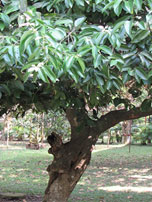SHAHEED KARTAR SINGH SARABHA AYURVEDIC MEDICAL COLLEGE & HOSPITAL
Affiliated to Guru Ravidas Ayurved University, Hoshiarpur Punjab
Affiliated to Guru Ravidas Ayurved University, Hoshiarpur Punjab

Botanical Name : Cinnamomum zeylanicum.
Family : Lauraceae
Introduction :
It used for the food more taste. Cinnamon, common name for several related trees of the laurel family, and for a spice made from the dried bark of the trees. The best-known species is native to Sri Lanka; it is cultivated in many other tropical countries in Southeast Asia and elsewhere, but that grown in Sri Lanka is superior in taste. The tree, which usually grows up to 12 m (40 ft) high, is cultivated to grow four to five stems. When the bark begins to turn brown, the stems, which may be about 2.5 m (about 8 ft) tall and 5 cm (2 in) in diameter at the base, are harvested and new ones are trained to grow in their place. After the tree is stripped of leaves and twigs, the inner and outer bark is removed. As the bark dries, it forms rolls (quills), the smaller of which are inserted into the larger, and when fully dry, these are tied in bundles for shipment.
Names in different Indian languages :
English : Cinnamon,Ceylon Cinnamon
Hindi : Dalcini
Kannada : Dalcini
Malayalam : Ilavangam, karuva, vayana, elamangalam
Sanskrit : Tvak
Tamil : Ilavagam,karuva
Telugu : Dalcini,dasini cekka
Unani : Daarchini (bark).
Synonyms :
Cocam,darusita, daaruchini, Chochaa, Choncha, Varaanga, Utkata, Daarusitaa (bark).
Cinnamomum verum Persl.
Classification according to Charaka, Susrutha & Vagbhata :
Charaka
Susrutha
Elãdi
Vagbhata
Elädi, Trijataka
Varieties & adulterants – (CV – controversy, AD – adulterants) :
1. C. tamala – [AD]
2. C. cassia -[AD]
3. Dãrusitã (sweet variety)
4. C. cassia
5. C. jamala
6. C. verum
Morphology :
A small evergreen tree, 6-7.5 m high.
Bark— brown and rough (in aged trees); inner surface of commercial bark is somewhat darker than the outer and finely striated longitudinally.
Leaves—coriaccous, glaucous green above, with spicy odour when bruised, 3-5 veined, 10-20 cm. long.
Flowers— small, with disagreeable smell.
Fruits— ellipsoidal, 1-seeded, dark purple berry, 1.5-2.5 cm long. Flowers and fruits during the spring.
Habitat & Distribution :
Found wild in the southern costal region of western India. The main source of cinnamon is Srilanka. Also grows in Brahmadesha, China, Southern.India and Himalayas.
Chemical Constituents :
Cinnamaldehyde, eugenol, benzaldehyde, methyl amyl ketone, phellandrene, pinene, cymene, linalool, cumic aldehyde, caryophyllene, safrole, methyl evgenol, borneol, cinnamyl alcohol, cinnzeylanin, cinnzeylanol, epicatechin, cinnacassiol D1 etc.
Properties :
Rasa Katu, Tikta, Madhura
Guna Laghu, Ruksa, Tiksna.
Virya Usna
Vipãka Katu
Karma : Vãta-pittahara, Sukrala, Balya, Varnya, Grãhi ,depana,pachana
carminative, digestive, astringent, antispasmodic, expectorant, haemostatic, antiseptic
Indications :
Kandü, Amãjirna, Aruci, Hrdroga, Bastiroga, Vãtãrsas, Krmi, Pinasa, sukradosa
diarrhoea and dysentery; gastric irritation,nausea and vomiting, toothache, neuralgia,rheumatism, cough
Part Used :
Stem bark, oil and leaves
Dosage :
Powder 2-4 g, oil 2-5 drops
Chemical composition :
It contains 2% volatile oil which is called as oil of cinnamon, It also contains cinneric acid, resin, tannin, sugar, starch, mucilage and ash. Like bark, oil is also derived from leaves and root. Leaf oil is dark in colour and has clove-like aroma. Root oil is yellow coloured and water insoluble.
External use :
It is stimulant and analgesic. It is used for mouth wash in bad breath and keeps teeth healthy, This is done by chewing of cinnamon. Chewing of cinnamon helps in nausea. The paste is applied in skin diseases like moles and skin tags etc. It is applied locally in headache and also in inflammation. In dental cavity cotton wool soaked in 2-3 drops of cinnamon oil relieves pain. In a chancre, oil or paste is locally applied on penis. Cinnamon oil relieves pain and inflammation caused due to scorpion bite. It is also used for cleaning and healing of tuberculosis ulcer.
Internal uses :
Nervous system : Cinnamon is used in neural debility and paralysis.
Digestive system : It is an appetizer, digestive, carminative, liver stimulant and astringent by bitter, pungent and ushna properties. Hence it is useful in anorexia amadosha, abdominal pain and haemorrhoids.
Circulatory system : It is a cardiostimulant, blood purifier and promotes white blood count. Therefore, it is used in cardiac debility and blood disorders caused due to bacterial infection.
Respiratory system : It is an expectorant and antitubercular drug. Cineremic acid seems to have an antitubercular property. It acts as a hemostat, ulcer healer and foul smell scavenger in lungs. Urinary system : Its ushna and tikshna properties stimulate the bladder and act as a diuretic. Effective in disorders induced by kapha and meda.
Reproductive system: it shows aphrodisiac properties. Hence it is useful in amenorrhea and infertility. Ashoka + cinnamon used in uterine laxity. Fever : It reduces intestinal foul smell in enteric fever. Oil is also used.
Important Yogas or Formations :
Elãdi rasayana, Sitopalädi cürna,Samasarkara curna.
Important research work going on :
(1) Acqueous anti-complement activity
(2) Effect of Cinncassiol –D in anticomplement activity
(3) protein level
(4) anti-allergic activity
Therapeutic Uses :
(1) Kãsa— Powders of Tvak, Elã, Pippali, Tavaksiri and sugar (each double than the other in quantity) are mixed together and taken with honey (A.H.).
(2) Sirasula— Nasya with Tvak Kalkã, Patra and sarkarã along with ice-water is useful in Pittaja sirasula (C.S.Ci. 26! 178)
(3) Prayãhikã– Tvak powder is given in 1 g dose (T.N. ghosh).
